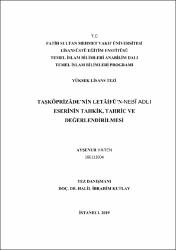Taşköprizâde’nin Letâifü’n-Nebî Adlı Eserinin Tahkik, Tahric ve Değerlendirilmesi
Citation
YAREN, Ayşenur, Taşköprizâde’nin Letâifü’n-Nebî Adlı Eserinin Tahkik, Tahric ve Değerlendirilmesi, Fatih Sultan Mehmet Vakıf Üniversitesi Lisansüstü Eğitim Temel İslam Bilimleri Anabilim Dalı, Yayımlanmamış Yüksek Lisans Tezi, 2019.Abstract
Bu çalışma, Osmanlı âlimlerinden ⅩⅤ. ve ⅩⅥ. yüzyıllarda yaşayan Taşköprizâde Ahmed Efendi’nin yazma eser şeklinde kütüphanelerde bulunan Letâifü’n-Nebî isimli kırk hadis şerhi üzerinedir. Çalışmada bu eserin tahkiki, hadislerinin tahrici ve değerlendirilmesi yapılmıştır.
Tez, bir giriş ve üç bölümden oluşmaktadır. Birinci bölümde Taşköprizâde’nin yaşadığı dönemin siyasî ve ilmî durumu ile hayatı hakkında bilgi verilmiş, tespit edilen eserlerinin isimleri zikredilmiştir.
İkinci bölümde Taşköprizâde’nin Letâifü’n-Nebî isimli kırk hadis şerhi kapsamlı olarak değerlendirilmiştir. Bu bölümde Hz. Peygamber’in (sav) mizah anlayışı ve Kırk Hadis (Erbaûn) türü hadis kitapları hakkında bilgi verildikten sonra Taşköprizâde’nin bu eserdeki metodu detaylı bir şekilde ele alınmış, eserin yazma nüshaları tanıtılmış, tahkik ve tahricte izlenilen yöntem belirtilmiştir.
Tezin üçüncü bölümünde ise Letâifü’n-Nebî isimli eserin tahkiki ve hadislerinin tahrici yapılmıştır. Bu bölüm Arapça olarak kaleme alınmış ve burada başvurulan kaynaklar bölümün son kısmında Arapça bir kaynakça ile verilmiştir.
Araştırmamız sonucunda, Hz. Peygamber’in (sav) mizah anlayışına ışık tutan bu eserde, müellifin hadisleri seçerken asıl olarak konu birliğine dikkat ettiği, bununla birlikte zikrettiği rivayetlerin çoğunluğunun kabul ve red açısından sahih, hasen ve makbul hadisler olduğu görülmüştür. This study is on 15th-16th century Ottoman scholar Tashkoprizade Ahmed Efendi’s commentary book on forty hadith, titled Lataifu’n-Nabi, which is found in libraries in manuscript form. The investigation of the manuscripts, the extraction and authentication of the hadiths, and the evaluation of the book is conducted in this study.
The thesis consists of an introduction and three chapters. The first chapter gives information about Tashkoprizade’s life, and political and scholarly situation of the period. The list of his identified works is also presented in this chapter.
The second chapter contains the comprehensive evaluation of Tashkoprizade’s Lataifu’n-Nabi. After describing the Prophet's (pbuh) understanding of humor and the Forty Hadith genre books, this chapter discusses Tashkoprizade’s method in this work, introduces the manuscripts of the book and explains the methods followed in the investigation and authentication.
In the third chapter, the verification of Lataifu’n-Nabi and authentication of the hadiths are conducted. This chapter is written in Arabic and the sources cited in this chapter are presented in an Arabic references list at the end of the chapter.
As a result of our research, it has been observed that in his work which illuminates the Prophet's (pbuh) understanding of humor, the author’s primary concern in choosing the hadiths was to ensure the content integrity. Yet, the majority of narrations he cited were sahih, hasen, and makbul hadiths.



















